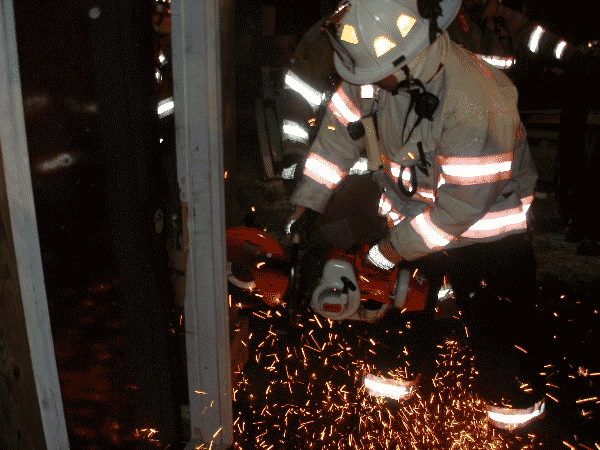

There are many different types of cutting tools. There tools are often specific as to the types of materials they can cut and how fast they can cut them. There is no such thing as a single, universal cutting tool that will efficiently cut all materials. Using cutting tools on materials for which it was not designed can destroy the tool and endanger the operator. Cutting tools can be either manual or powered.
The axe is the most common type of cutting tool available in the fire service. There are two basic types of axe configurations in use today: the pick-head axe and the flat-head axe.
The pick-head axe comes with either a 6-pound head or an 8-pound head. Handle sizes vary according to specifications, but they are made of either wood or fiberglass. The tool is very effective for cutting through wood, shingles, and other natural lightweight materials. The pick end serves to give the firefighter an opportunity to make a starting point to begin cutting or to pierce materials.
Like the pick-head axe, the flat-head axe comes in either 6- or 8-poiund head weights with either a wood or a fiberglass handle. It also cuts through a variety of natural materials. When paired with a prying tool, the flat-head axe becomes a vital addition to the forcible entry team because the flat head can be used as a striking tool .
Power saws make fast and efficient cuts in a variety of materials. However, like any other tool, there are times when these saws should and should not be used. Power saws can be divided into several categories including rotary (circular) saws, reciprocating saws, and ventilation saws. Some precautions when using power saws include:
- Do not push a saw (or any tool) beyond the limits are its design and purpose. Two things may occur: tool failure (including breakage) and/or injury to the operator.
- Never use power saws in a flammable atmosphere. The saw's motor or sparks from the cutting operation can ignite a fire or cause an explosion.
- Always use eye protection when operating any power saw.
The Rotary (Circular) Saw:
This saw is also commonly known as a "K-12 Saw." The fire service version of this device is most often gasoline powered and has changeable blades. The blades often spin more than 6,000 rpm. Blades range from large-toothed blades for quick rough cuts to fine teeth for a more precise cut. Carbide-tipped teeth are available and are far superior to standard blades because they are less prone to dulling with heavy use. Blades specially designed for cutting metal, wood, or concrete are available. There are also combination blades that will cut all three using one blade. However, these blades are not as strong as an individual blade designed to cut a specific type of material. As there are many manufacturers of rotary saws, the firefighter should be familiar with his department's version.

The Reciprocating Saw:
The reciprocating saw is a very powerful, versatile, and highly controllable saw. It can use a variety of blades for cutting different materials This saw has a short, straight blade that moves forward and backward with an action similar to that of a handsaw. Its major drawback is that most reciprocating saws require electricity which may be be readily available on the fireground. However, many models can be purchased that include battery packs and a charger, which provides mobility. A reciprocating saw can be very beneficial in a number of forcible entry situations.
Ventilation Saws:
The ventilation saw is a relative newcomer to the fire service as a forcible entry tool. Most of the time it is used for ventilation, but is should not be overlooked for certain forcible entry situations. It is sometimes more efficient than the rotary saw. It is important that the ventilation saw is powerful enough to penetrate dense materials, yet lightweight enough to be easily handles in awkward positions. When equipped with a carbide-tipped chain, depth gauge, and kickback protection, the saw makes fast cuts through natural materials. it should not be used to cut metal. Lightweight and capable of being held at various angles, again, the ventilation saw should not be overlooked as a forcible entry tool in certain situations.